|
The 1967 Viy is one of a select group of acclaimed films that I was long ago aware of but that I somehow never got around to seeing and that slipped off my radar in the years that followed. Indeed, when the release of this Blu-ray was announced by Eureka, it took me a while to realise that it was the film that I had read about and taken such an interest in all those years ago. Despite the high regard in which it is held, it’s still not as widely seen in the west as the altogether looser adaptation of the highly respected Nikolai Gogol novella on which it is based, Mario Bava’s haunting and visually striking 1960 horror masterpiece, Black Sunday [La maschera del demonio]. Then again, there are probably sound reasons for that. When I happened to mention to a younger friend that one of the discs that I had recently received for review was a Russian supernatural horror film made during the Soviet era, he was genuinely surprised, rightly remarking that Russia wasn’t exactly known for its horror movies. This turned out to be something of an understatement. Viy, I quickly learned, isn’t so much unusual on this score but unique, and is thought to be the only major film made during the 74-year history of the Soviet Union that could be classified as supernatural horror. If I hadn’t already been intrigued by it by then, this fact alone would have had me wanting to see it. But oh, there are so many other good reasons to make a point of doing so, and Viy isn’t just unique in the annals of Soviet cinema, it’s quite unlike any other genre movie from the period that you’re likely to have seen. It’s also – and I genuinely wasn’t prepared for this when I sat down to watch it – a great deal of fun.
The film begins in bright sunshine as a Kiev seminary breaks up for the summer and the students are given a final lecture on their previous rambunctious behaviour by the Rector (Pyotr Vesklyarov) before they all depart for home. That these young men are training for the priesthood doesn’t seem to have installed a sense of piety into them, as once set free they effectively run riot, stealing food from the local market and chasing local women. As night falls, three of them – Khoma Brut (Leonid Kuravlev) and his friends Gorobetz (Vladimir Salnikov) and Khaliava (Vadim Zakharchenko) – are still in transit and looking for somewhere to safely spend the night. It’s then that they come across an isolated farmhouse and persuade its initially reluctant elderly female owner, Vedma (played by male actor Nikolai Kutuzov), to let them in. She claims to have little in the way of spare room and assigns each of them a different location to bed down, with Khoma ending up in the stable with the cows. He’s just making himself comfortable in the hay when Vedma walks in and appears to make moves to seduce him. Khoma tries to fight her off but Vedma energetically persists, then jumps on Khoma’s back, grabs a broomstick and takes to the skies with him. The terrified Khoma realises he has been kidnapped by a witch and begins uttering prayers for his safety, which saps Vedma’s power and sends them plummeting to earth, where Khomer quickly grabs the shaft of the broomstick and violently beats Vedma with it. When she cries out for mercy, a change in the tone of her voice causes Khoma to pause and realise that the old witch has transformed into a beautiful young woman, which prompts him to drop the broomstick and run.

Eventually, a weary Khoma makes his way back at the seminary but has not been there long before he is summoned by the Rector. He has just received an important communication from one of the region’s wealthiest Sotniks* (Aleksei Glazyrin) whose daughter, Pannochka (Natalya Varley), is apparently on her death bed after being savagely beaten by an unknown assailant, and her last request was that Khoma Brut be the one who says her final prayers. Khoma is still shaken from his recent experience and is not at all keen, but the Rector makes it clear that he either does as he is ordered or be unpleasantly punished, and Khomar thus reluctantly joins the five ageing Cossacks who have been sent by the Sotnik to ensure that he reaches his assigned destination.
Quite aside from the film’s fantasy elements, there are a couple of enjoyably playful absurdities in Viy. The first comes in the shape of Khoma’s failure to see a connection between the Vedma’s transformation into a young woman after he savagely beat and the dying request of the daughter of a local Sotnik who has apparently suffered the very same fate. That he’s reluctant to take the job appears to be more down to inherent laziness and the fact that he’s still shaken up after his encounter with the witch than any realisation regarding what he’s being forced to walk into. It’s a supposition later confirmed by his shocked recognition of Pannochka and his almost comical denial that he and she had ever met when questioned by her distraught father over why she would have specifically asked for him. This lack of awareness doesn’t prevent him from making two low-key escape attempts during the course of the journey to the Sotnik farm, but his five white-haired escorts are clearly quite capable of putting a firm but friendly halt to any such nonsense. Even when the party stops off at an inn to get absolutely plastered, the Cossacks are able to keep the equally drunk Khoma in check and redirect any attempt he makes to quietly slip away.
By the time they reach the Sotnik abode, however, Pannochka has died, and it’s here that it dawns on Khoma that he was the mystery assailant who inadvertently killed her. Unable to take revenge on a man whose identity he does not know, the Sotnik is determined to honour his daughter’s last request and thus commands Khoma to observe a ritual in which he has to spend three nights alone in the company of the now deceased Pannochka reciting prayers for the salvation of her soul. If he does this, he later informs the young man, he will receive a princely one thousand gold pieces, but if he refuses, he can look forward to a thousand lashes from whips wielded by men who are experts in dishing out such punishment.
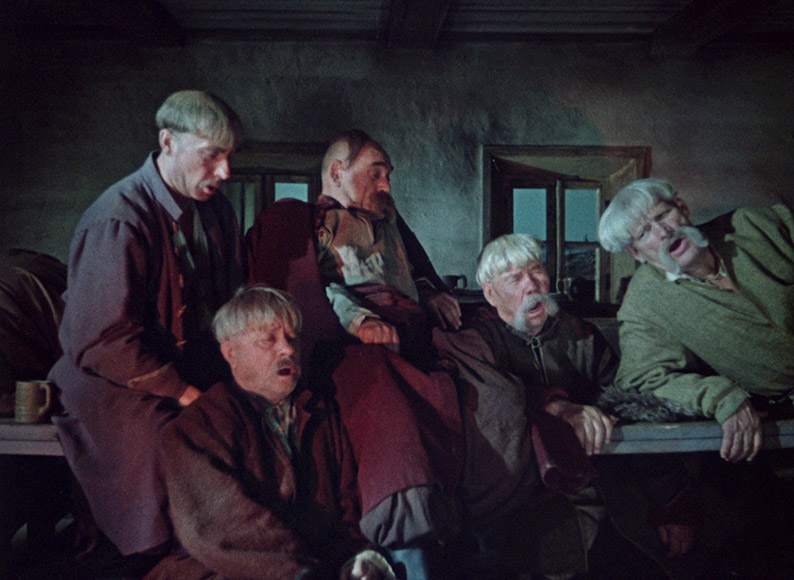
Up until now, the only clear indication that we’re in supernatural territory has been the broomstick ride and Vedma’s subsequent but off-screen physical transformation, and it’s not until the journey to the Sotnik farm that we get a taste of the effects work to come. When Khomer and the Cossacks get drunk at the inn, back projection is employed to subjectively illustrate Khoma’s drunken paranoia, as the same Cossack enters through three adjacent doors while the wobbling Khoma looks on in unsteady discomfort. It’s a neat effect that plays on Khoma’s one failed attempt to leave the inn unnoticed, but of equal interest is a brief use of the same optical technique to capture Khoma’s drunken unsteadiness in a shot that predates Martin Scorsese’s more elaborate (and genuinely stomach-churning if you see it on the big screen) take on the same in Mean Streets. By this point I’d become rather fond of this merry bank of Cossacks, who while ready to discharge their duty to their master cannot resist pausing their journey to get collectively plastered. I think I actually paused the film to grab a drink at this point.
It’s once Khoma is locked into the sort of gothic wooden church that would probably give even drunken Cossacks the heebie-jeebies that the film really starts to earn its horror credentials, and it would be unfair of me to reveal too much about what unfolds. I’ll thus try not to get into specific detail but considering this is what the first half has effectively been building up to – and that it absolutely proves worth the wait – I can’t just give it a quick mention and move on. Those wishing to go in to the film blind, so to speak – and this really is worth doing if you can – should thus hop to the final paragraph to avoid stumbling across even minor spoilers, or click here to do so automatically.
Khoma is required to spend three nights in the church with Pannochka’s open coffin and given what we know about her alternate identity, we all know full well that something strange will happen. That she rises from her coffin on the first night is thus not that surprising, but that she appears to be robbed of her vision and forced to feel her way to a protective bubble that Khoma has created around him definitely is. This raises some interesting questions about the netherworld in which Pannochka seems to be located, and while the chalk circle that Khoma draws around him for protection is never given a verbal explanation, it just seems to make sense within the context of how the story plays out. A year later, a similar (if considerably more complex) hand-drawn chalk circle would be used as protection against evil forces in Hammer’s thrilling Dennis Wheatley adaptation The Devil Rides Out, where a clearer indication of its protective properties is provided. Here it’s left to us to determine this, which we do from Khoma’s desperate actions and Pannochka’s inability to cross the invisible barrier that it creates. That things will escalate the following night also seems likely, but few will be able to predict the nature of Pannochka’s change of tack here, and I can almost guarantee that nothing will prepare you for the extraordinary onslaught that is unleashed on the third night. By this point, Khoma seems fully aware that he is facing a battle for his very existence, and after failing to convince the Sotnik to free him of his duties – this is where he learns about the punishment he will face if he does not see it through – he gets drunk before re-entering the church, a course of action that had me genuinely tensed up at the prospect that might be too pissed to draw the circle that remains his only real means of protection.
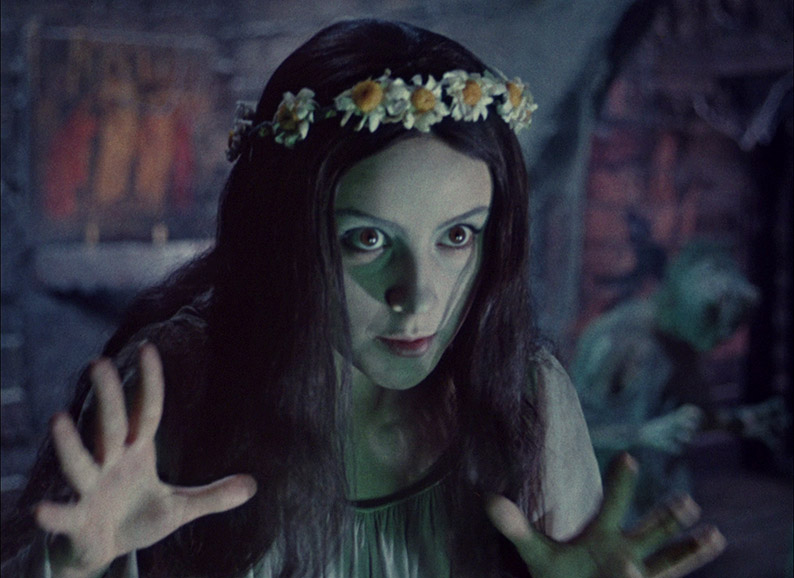
While the direction is credited to both Konstantin Ershov and Georgiy Kropachyov, a case is made in the accompanying booklet that screenplay co-author, art director and special effects supervisor Aleksandr Ptushko was a driving force here. Frankly, I’m in no position to confirm or deny this with any authority at all but will say that there’s never a sense that the film is being pulled in different directions by ununified voices. It’s certainly a film of two halves, so to speak, with the entertaining and intermittently humorous first half giving way to full gothic supernatural horror in the second with scenes that have the atmosphere of top-drawer Hammer and moments of inspired madness worthy of Ōbayashi Nobuhiko’s Hausu, with breaks to give both Khomer and the audience a chance to get their breath back in the daylight hours before battle re-commences. The playful absurdities continue with nightly vigils that seem to pass in a flash, playing out in real time but brought to a halt by a crowing cockerel less than ten minutes after Khomer has entered the church. Does it matter? Not a hoot. The normal rules of time and space just don’t apply here (I’ve yet to see a definitive statement about when the film is set), and there’s a very real sense that objective and subjective are intermingling, with events presented not as they occur but as they are experienced by the increasingly terrified Khoma. Add to that the film’s fluid and consistently engaging storytelling, the sly comical moments and seemingly throwaway detail whose full meaning only really registers on a second viewing, and any holes you might think to pick in the surface logic seem churlish and misplaced.
As Khomar, Leonid Kuravlyov makes for a most engaging reluctant hero in a story where heroism plays no real part, the unwitting instigator of events that are destined to ultimately shape his fate. His “oh, do I have to?” reluctance to take on the job assigned to him by his Rector and his repeatedly foiled attempts to wheedle out of it make him an easily likeable figure whose fate I found myself increasingly invested in. When things really hot up in the later stages, his wide-eyed terror and the physicality of drunken circle-drawing and terrified recoiling adds to the dynamism of scenes that are driven largely by movement, of Khomar, of Pannochka, of the dynamo sweeps of Viktor Pishchalnikov and Fyodor Provorov’s cinematography and even the optical and physical effects. Equally captivating is Natalya Varley as the undead Pannochka, her determined and vengeful first night glares and her initial sightless search for her assailant giving way on the following night to something more inventive, which peaks when she rides her coffin around the church interior like the Silver Surfer played by Morticia Addams. As with Kuravlyov, the physicality of her performance is a key factor here, from her energetic, mime-like movements on the first night to a brief but genuinely startling moment when she glares at Khoma and judders violently in sync with a jittering skeleton, just one of the mind-boggling collection of creatures she summons to aid her in her assault.
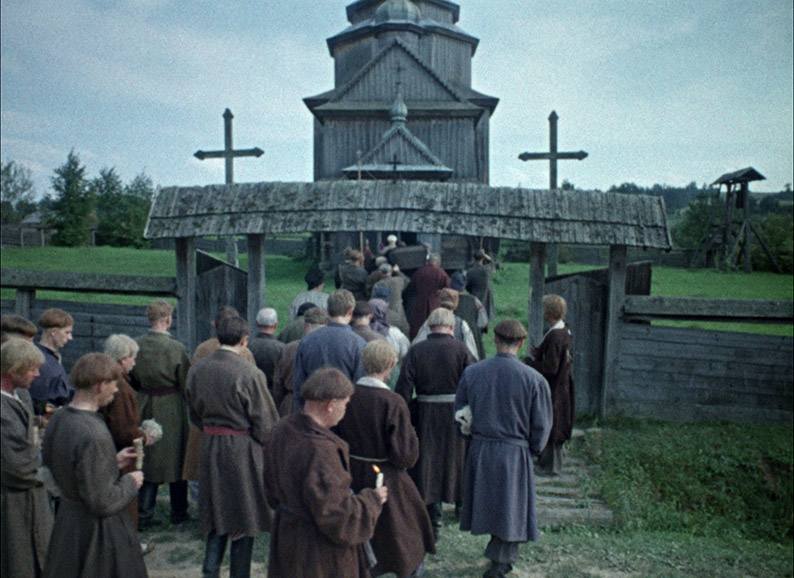
Although highly regarded, Viy is still not as widely seen as it deserves to be, and I’ve no doubt that this is down more to its country of origin than any perceived availability issues. That said, it’s genuinely worth putting the film’s reputation aside and going in with no preconceptions to let it surprise and delight you in ways that you will likely not have predicted. It’s a one-of-a-kind work that kicks against some too-common misconceptions about Soviet Russian cinema, and is as imaginative, as briskly paced, as creepy and as fun as any western genre equivalent of the day. If, of course, such a beast actually exists.
Sourced from a digital restoration by Cinema Concern MOSFILM, the dual layer 1080p transfer here is framed in the film’s original aspect ratio of 1.37:1 and is, for the most part, seriously impressive. The image is stable in frame, the pastel-leaning colour palette is attractively rendered, and the contrast is very nicely graded – the very slightly overexposed look to some of the daylight scenes appears to be deliberate and does not vary from shot to shot. Detail and sharpness are very good on close-ups and mid-shots, though can soften a little on some of the wides, but never problematically so. The picture is clean, with no signs of damage repair, and a fine film grain is evident.
The Linear PCM 2.0 mono soundtrack is also clear, though with a very slight layer of background fluff detectable if crank the volume up to dangerous levels. The dialogue and effects are clear, albeit with the expected range restrictions, but the splendid orchestral music score by Karen Khachaturyan (nephew of celebrated composer, Aram Khachaturian) sounds clear and full-bodied enough to make me wonder if the music was remastered as part of the restoration process. No complaints here.
Also included is an English dub, and while I’ve heard far worse, it’s definitely no way to watch this film. Quite aside from hearing Russian Cossacks speaking with American accents using words that their mouths clearly aren’t forming, some (though by no means all) of the dialogue has not been mixed to sound as if it was recorded on location, so does have a degree of post-production artificiality.
Optional English subtitles kick in by default, but the option to play the film with English subtitles for the deaf and hearing impaired is also available.
Disc 1
Commentary by Michael Brooke
This new commentary by film historian and Eastern European cinema expert Michael Brooke moves at a serious lick and is so crammed with information on the film and a range of related subjects that I had to keep pausing it to make notes so that I could more accurately recall what ground was covered. It includes information on the origins of the film, the locations, the underlying themes, Russian monasterial ranks, social and historical details, why horror played almost no part in Soviet Russian cinema, the actors, the directors, the cinematographer, the art director, the music score, and a whole lot more. Details that might not be instantly obvious to a modern western audience are clarified, sometimes using quotes from Gogol’s novella, and other film adaptations of which are discussed, as well as details of an on-set accident, the dubbing of actor Natalya Varley’s voice, the links to Dostoevsky’s Crime and Punishment, and the film’s reception and distribution. We even get a scientific debunking of the notion that a person’s hair can turn grey from shock overnight. I’m just scratching the surface here. A superb special feature that I learned a huge amount from.
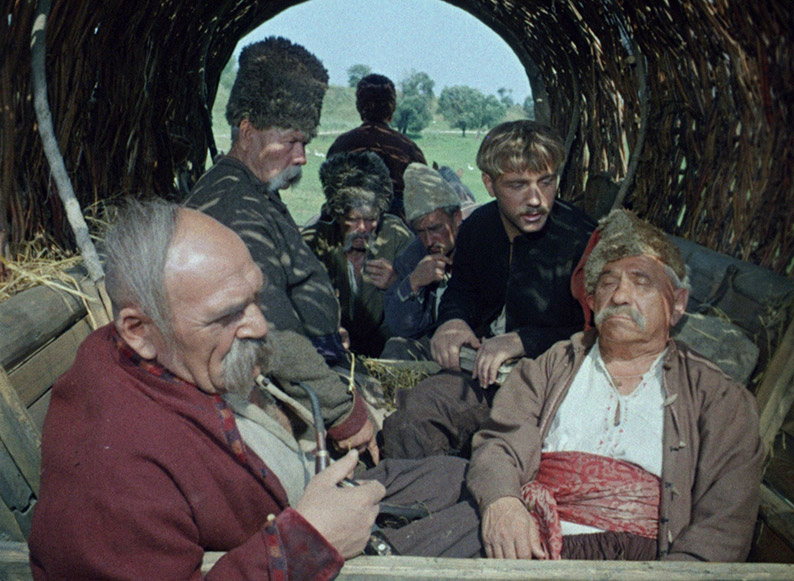
Samuel Goff on Nikolai Gogol (15:05)
Au audio essay by Samuel Goff on the literary career of Viy author Nikolai Gogol, an icon of Russian literature who was dubbed the first Russian realist, despite the fact that he was actually Ukrainian. Goff discusses the very religious Gogol’s lifelong affinity with the supernatural and talks about this cinematic adaptation of one of his most celebrated works, which includes some analysis of the final scene, so steer clear of this until after watching the film. Stylistically, this is almost the polar opposite of Michael Brooke’s commentary, whose energy and enthusiasm had me consistently rivetted – Goff’s delivery is far more laid-back, so much so that I almost found my attention wandering a couple of times. Well, it was late evening. The content, however, is of very real interest. One small complaint – having the same portrait of Gogol on screen for the entire length is likely to get us OLED screen owners a little on edge.
Remembering Nikolai Gogol (19:06)
An archival documentary about author Nikolai Gogol that has Soviet Russia all over its tone and approach, complete with upbeat narration, emotive orchestral score, a romantic view of Gogol’s youth and formative years, and an almost heroic presentation of the writer and his work. It’s still absolutely of interest, particularly for the shots of Gogol’s tightly packed original manuscript and the information about his friendship and work with the poet Alexander Pushkin.
Russian Silent Film Fragments
Three fragments from longer Russian silent films, the remainder of which may or may not have been lost – unfortunately no further information is provided on the disc or in the accompanying booklet. The first one relates to Nikolai Gogol, the second to his friend and compatriot Alexander Pushkin, the third…well, I’m not sure about the third, except that it has the same director as the second.
The Portrait 1915 (7:53 from a 45-minute original)
A 1915 adaptation of Gogol’s 1835 short story of the same name directed by Vladislav Starevich. The sequence included here is not that cinematically adventurous – the camera stays locked on the same wide shot for the majority of the running time – but content-wise it’s of considerable interest. A man visits a gallery and buys a painting that the gallery owner clearly thinks is of little value. When the buyer hangs it on his bedroom wall at home, however, he soon becomes haunted by it, then in a dream sees the of the portrait come to life. The surprisingly naturalism of the performances in the opening gallery scene gives way to a genuinely creepy sequence that, in its way, prefigures one of the most famous sequences in modern Japanese horror cinema.
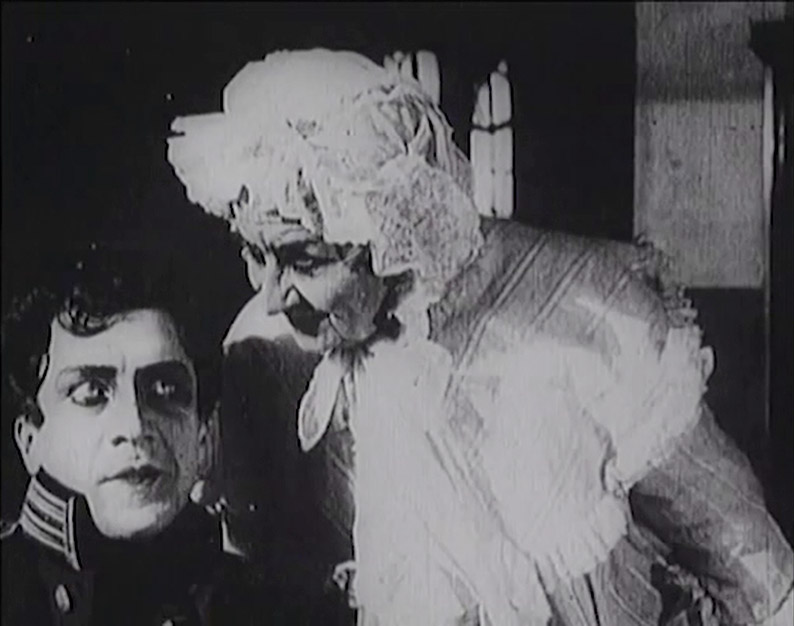
The Queen of Spades (16:30 from an 84-minute original)
A 1916 adaptation of a story by Alexander Pushkin, directed by Yakov Protazanov, that has a significant connection to Viy in the shape of an elderly Countess (who again appears to be played by a male actor) with mystical powers who can transform into a younger woman. Here she is approached by a soldier who is soon to marry and who has heard of her ability to predict three winning cards, information he tries to force out of her in order use it to quickly get rich by gambling. Things, however, do not quite go to plan… A more cinematically lively work than The Portrait, and although not as creepy, it’s pleasing that we get to see how this section of the film concludes.
Satan Exultant (19:30 from an 87-minute original)
Directed in 1917 by Yakov Protazanov, this intriguingly titled tale tells of a pastor who preaches chastity to his flock but learns the power of temptation when his house is visited by the Devil in the shape of an injured traveller. Cinematically as accomplished as The Queen of Spades, not surprising considering it was made by the same director, it’s of particular interest for the boldness of content for a film of its day, with the pastor visibly turned-on by the sight of a couple kissing and developing a strong desire for his friend’s wife.
Original 1967 Trailer (2:36)
A breathlessly paced American release trailer that includes way too much footage from the nightly vigils, including a sizeable chunk of the climax. Avoid at all costs before your first viewing of the film.
Disc 2
SVETO MESTO [A HOLY PLACE] (89:46)
It’s not often you get a complete feature film as a special feature, but that’s what we have here in the shape of director Djordje Kadijevic’s 1990 adaptation of Gogol’s Viy. If you’re wondering why this is in the extras instead of being accorded equal billing with the 1967 adaptation, I’ve come up with two possible reasons. The first is that this more recent interpretation of the story is far less well known than its predecessor, and Viy is more likely to sell this disc than A Holy Place. The second and frankly more plausible possibility is that while the image is often in very good shape, being impressively stable in frame with the detail and colour well defined, just occasionally it becomes busy with dirt and small flecks of damage, which builds to a crescendo either side of some the reel changes. This is unfortunate, particularly considering how clean and clear the picture is at its best, but it's also easy to live with for the chance to see this intriguing alternative take on the story.
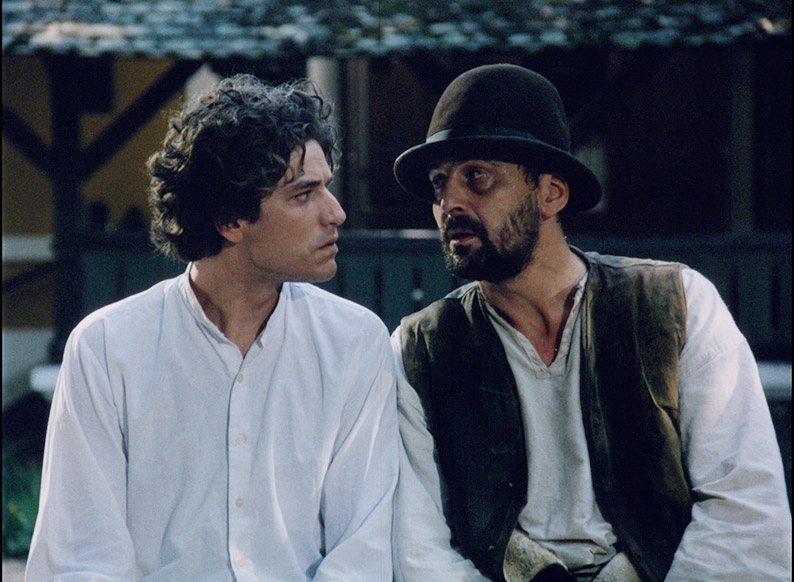
The film follows most of the same story beats as Viy but adds a few elements absent from that version and, in some cases, also not in the original novella. Some of these impact on the story, the subtext and how we perceive the main characters. A Holy Place begins with the three students already having already left the seminary and in search of lodging for the night. The story then unfolds much as it does in the novella and the 1967 film adaptation, but with a couple of interesting alterations. Here, shortly before the three men reach the farmhouse, Khoma replacement Toma (Dragan Jovanovic) is passed by a black carriage in which Pannochka replacement Katarina (Branka Pujic) is travelling. Two significant things happen here. The first is that Katarina eyes up Toma seductively as she passes, which suggests that she had already targeting him specifically before approaching him later in the form of the old woman. The second is that neither of Toma’s companions see the carriage, in spite of the fact that it should have almost run them over as it passed, which suggests early on that Katarina is a supernatural figure. The symbolic function of carriage does risk overstating an aspect of the story that worked well enough without it – having it parked at the estate of Katarina’s father, Gospodar Zupanski (Aleksandar Bercek), when Toma arrives, for example, only really serves to ominously clue Toma into something he’ll have confirmed anyway a few seconds later.
A second alteration comes after Toma has beaten the old woman and she has transformed into Katarina. Instead of fleeing the scene as Khoma does in the 1967 film, Toma attempts to comfort Katarina and finds himself strongly attracted to her. He begins kissing her and although seriously injured, she appears to respond to Toma’s actions, and at one point this looks as though it’s going to go a morally suspect step further. Though Toma does then flee the scene, this encounter builds further on that fleeting first contact between the two and further personalises the action taken by Katarina in the final scenes.
Where the film does expand on the 1967 version is in the three stories told about Katarina’s former witchy misdeeds by members of the Zupanski household staff, which here unfold in sepia-toned flashback. While this may be true to Gogol’s novella, the tales told here have a different slant to those in the literary original and collectively paint a picture of a woman who was sexually abused by her father and as a result developed a hatred of men, whom she seduces and punishes, in one case by jumping so violently on the man’s genitals that it drives him insane. Only later, in a third flashback, are we given a possible alternative reason for her decision to target this particular individual.
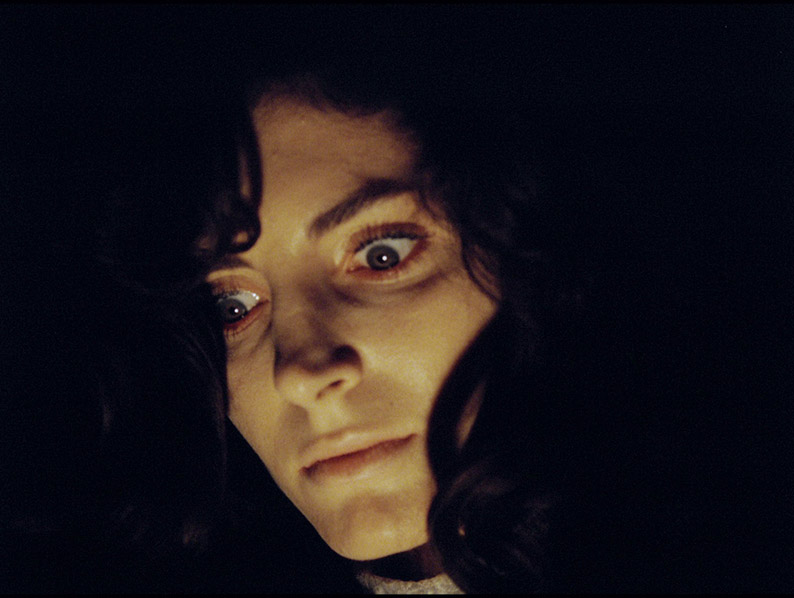
A Holy Place feels like a smaller and far lower budgeted film than Viy, but that also gives rise to a more low-key approach to the same story. The five Cossack escorts of the early film have here been reduced to two, and the three nights of vigil are a lot less visually spectacular, though they still contain one splendidly executed jump scare and a some genuinely creepy imagery. What will catch you out if you come to the film shortly after watching Viy (spoilers for both films ahead – hop to the next paragraph to bypass) is that the climactic assault on the senses of the earlier film has been cut down here to a single act of violence recycled from an earlier flashback scene, albeit one that concludes in a manner that is open to more than one reading. The next morning payoff, however, is in some ways even worse for Toma than the fate he suffered in the earlier film, and the irony of Zupanski’s outrage is not lost given the true nature of his relationship with his daughter.
I’m not going to claim that A Holy Place is on a par with Viy, but I still found it enthralling for its more realist take on the same story, although I did become aware that I was mentally ticking off all of the story points that it shared with the earlier film and noting where it differed, which I suspect contributed to my enjoyment. Although the influences of films that would not have been so widely seen in Russia back in 1967 are sometimes visible here, director Djordje Kadijević’s low-key approach and a sympathetic central performance from Dragan Jovanovic made me really feel for Toma, particularly as I was by then aware – or at least I thought I was – of the fate that ultimately awaited him. Ignore the occasional rainstorm of luminous dirt on the print – this is a fascinating companion to Viy and an extremely worthwhile inclusion in the package.
Djordje Kadijević on ‘A Holy Place’ (27:50)
A Holy Place director Djordje Kadijević – who is positioned a little uncomfortably distant and low down in a frame that is dominated by a large portrait that hangs above him – looks back at how his early counter-revolutionary war films led to him inadvertently becoming part of the ‘Yugoslav Black Wave’, and how a polite but firm block on the making of any more such films led him into television and eventually towards the fantasy genre. Having almost been forced into this position by the authorities, he recalls telling himself, “Alright, you will no longer be making war films, you will be making fantasy films instead, but you, gentlemen, who brought me to this situation because of your ideological fervour, this fantasy will scare the shit out of you.” He admits that Gogol is his favourite author and that he wanted to adapt Viy almost from the moment her started making films, in part because of the story’s similarity to a Slavik folk tale but also because of the beauty of its writing. He provides a metaphysical reading of the film, tells the story of how Lucifer was cast out of Heaven, and admits that he always makes the Devil beautiful in his films. This is just a sampling of an interesting and valuable interview.

Booklet
There are two major essays here to savour. The first, by Tim Lucas, looks at the career of Aleksandr Ptushko, who is credited as the co-writer, art director and special effects creator on Viy, and makes the case that he was the principal guiding hand at every stage of its production. He then looks back at Ptushko’s film career and many of his key works in considerable detail, all but bypassing Viy to focus on the films on which Ptushko was the credited director and does so with an enthusiasm for the work that I found infectious. I really got a lot from this. In the second essay, Dejan Ognjanović looks back at director Djordje Kadijević’s 1973 TV film Leptirica [The She-Butterfly], considered the first Serbian horror film and one whose six-minute climax he describes as, “among the most frightening sequences of TV horror anywhere” (I really want to see this!) before moving on to a detailed examination of A Holy Place, which he argues at one point could be regarded as an anti-fairy tale. Again, this makes for compelling and educational reading, and frankly made me want to immediately re-watch the film with the author’s comments in mind. The main credits for both films have also been included, plus the usual notes about how to view the main feature and which ‘image enhancing’ settings on your TV should be switched off.
Absolutely worth the wait, Viy proved to be one of happiest surprises I’ve had from a Blu-ray release so far this year, a hugely imaginative and entertaining adaptation of a novella I now feel duty bound to seek out and read, very nicely transferred from a strong restoration and supported by a strong set of special features, the best of which is Michael Brooke’s information-packed commentary. But wait, there’s more, as this Limited Edition release also includes a second feature-length adaptation of Gogol’s story and an interview with its director, Djordje Kadijević, making this not just a welcome release but great value too. Highly recommended.
|